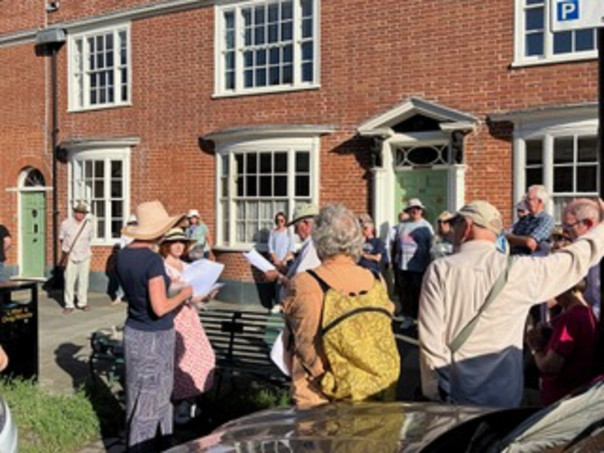Now that we are in September, even though in somewhat of a heatwave, I thought I would start with a short piece this week. Firstly, the ‘lost’ blogs from June and July have been redone and are as close as I can make them to those that disappeared. Secondly, we have a couple of joint CKHH events coming up before the end of the month, and thirdly, I just want to give a quick snapshot of three events we were involved in during August.
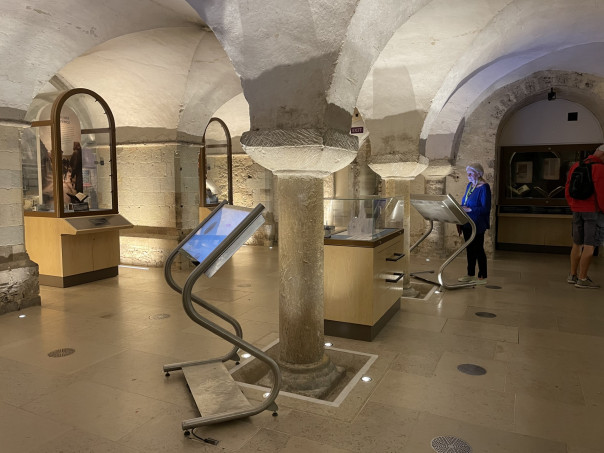
Looking forward, on Tuesday 26 September at 7pm it will be the annual Michael Nightingale Memorial Lecture which is a joint occasion organised by CKHH and Brook Rural Museum. As usual, the lecture is open to all and will be held in the Michael Berry Lecture Theatre in Old Sessions House (CT1 1PL). We are very grateful to the Graduate College at CCCU for covering the cost of the wine reception beforehand ie from 6.30pm in the foyer at Old Sessions.
This year our speaker will be Dr Adam Chapman, who is the General Editor of the Victoria History of the Counties of England (better known as the VCH) based at the Institute of Historical Research at the University of London. He will be speaking on ‘Medieval Landscapes in the Victoria County History: from text, to pictures, to text again’. As he says, “The VCH project is England’s – and possibly the world’s – longest established place-based history, having produced histories based on the parish since the beginning of the 20th century. Its ‘Big Red Books’ and, more recently series of place-based paperbacks or ‘Shorts’ provide an essential introduction and overview to the recorded history of England’s places having covered perhaps a third of England. It is active in 18 counties, and two Ridings of Yorkshire, but not – unfortunately – in Kent.
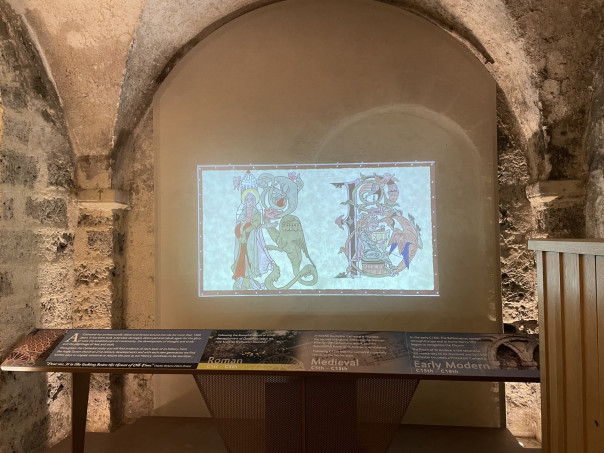
The histories the VCH produces are unique in scope, from the earliest recorded details to the ever-moving now and at the heart of it is the place of communities in the living, ever changing landscape. Adam will explore the sources, techniques, and processes used by the VCH with a selection case studies from existing work. and some examples from the Kentish landscape employing those approaches in Kent.”
This promises to be a fascinating talk and we will be delighted to welcome staff, students and visitors to the reception and lecture, booking is not required. There will be a retiring collection, part of which will go towards the Ian Coulson Memorial Postgraduate Award Fund and certificates to Award holders for the new academic year will receive certificates from the Lord Mayor of Canterbury.
Then on the following Saturday 30 September, the CKHH is teaming up with the Kent Archaeological Society Publications Committee to hold a one-day conference in Powell Lecture Theatre, Pg09 (CT1 1QU) entitled ‘Institutional Care through the Ages in Kent’ beginning at 10.30am and due to end at 4.30pm. Confirmed speakers are Peter Joyce, Chris Rowley, Jane Joyce and Dr Sheila Sweetinburgh. This free conference is open to all, please book at https://www.trybooking.co.uk/CQCF but if you have any difficulties, please email: sheila.sweetinburgh@canterbury.ac.uk for assistance. The Touchdown café nearby should be open at lunchtime and at the afternoon break.
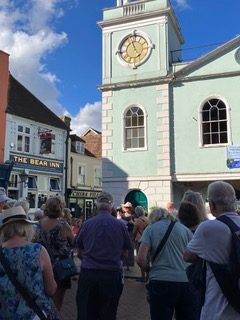
The conference will consider institutional care of the poor, infirm and disadvantaged in society, which has a very long history in Kent, starting from some if not the earliest hospitals in England up to the present day. For as is often said, the type and level of such care can tell us a great deal about society more broadly. Moreover, this conference will highlight new research that is taking place on different types of institutional care in Kent, from hospitals of different kinds to almshouses and workhouses, thereby providing insights concerning the lives of those inside and outside their gates.
That’s the future, now the past and I’m just going to mention two of the final events Dr Diane Heath and her team held in late August for her NHLF-funded ‘Medieval Animals Heritage’ project for SEND children and their families. Firstly, they visited the Rochester Bestiary exhibition at Rochester Cathedral on Monday 21 August and if you want to get a flavour of this excellent display, including Eleanor Smith’s great animation, please see: https://www.rochestercathedral.org/archive/beautyandbeasts
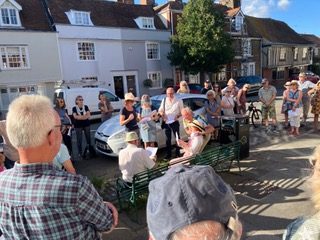
Then on Thursday 24 August, I joined Diane, Laine and Peter Joyce (PhD student) at Dover Castle for a series of creative workshops in the Princess of Wales Royal Regiment Museum. There the children and their families took part in stone rubbing (like brass rubbing) and stone carving under the watchful eye of Carrie, a professional stone mason; animal mask-making and photography helped by Joao, who had made his own replica Victorian camera, and trying their hand at calligraphy with quill pens under the tutelage of Julia, who runs workshops at the ‘Medieval Sandwich’ centre at the quay. To give them an even greater appetite for the picnic lunch (provided), the children and families visited the Great Keep where they met ‘young Richard I’ before some intrepid members of the group climbed to the top of the keep for the terrific views over the town and across to France. The event ended with Diane presenting certificates to all the children who had taken part – a fitting way to end this part of the project!
The final event from August I want to mention took place on Sunday 20 August as the finale of ‘Open Faversham’ which had seen a wide range of activities – workshops, exhibitions, talks etc taking place across the town over 10 days. For ‘Shakespeare in Faversham’, Jason Mazzocchi (PhD student) and I had teamed up with Elizabethan drama experts Professor Catherine Richardson and Dr Rory Loughnane from MEMS at the University of Kent with three of their PhD students: Hannah Grayson, Emma Rose Kraus and Laura Romain, as well as Heather Knight from MOLA. Having distributed a map (designed by Jason) of the route to our 80-strong audience (brilliant but somewhat larger than we had expected), Catherine introduced the guided walk before Rory provided background information on Elizabethan touring companies from London, some of whom we know visited Faversham.
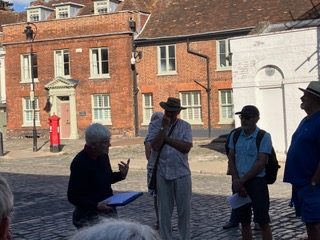
This was the pattern we adopted during the tour which took in places such as the various local inns, the old Guildhall, the Creek, Heather’s Tudor house, the Guildhall, marketplace, and a couple of stops in Court Street and Abbey Street. Consequently, we were able to give short talks on what Faversham would have been like in Shakespeare’s time, from the various entertainments such as bearwards coming with their bears to the town to dice and other games of chance, played ‘at home’ or in the many inns. At the Creek, Jason talked about the trade in oysters, and I explored goods and trade more generally, while on our way back to the Guildhall, Heather briefly showed people the front room of her house. The tour included two short play readings, the first from Macbeth and the second, not surprisingly, from Arden of Faversham, and sandwiched between the two I talked about schooling, education and languages in Tudor, especially Elizabethan Faversham, while Catherine discussed the type of goods people had in their houses, as listed in the Faversham inventories. All in all it was very successful, a great collaborative event involving the two universities. Moreover, we would also like to thank the volunteers from the audience who took some of the roles in the murder scene of Arden.
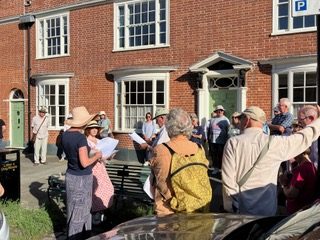
Thus, even though the CKHH blog had an (enforced) ‘rest’ in August, there was still plenty going on, a pattern that will continue into the autumn!
 Centre for Kent History and Heritage
Centre for Kent History and Heritage Sheila Sweetinburgh
Sheila Sweetinburgh 1342
1342